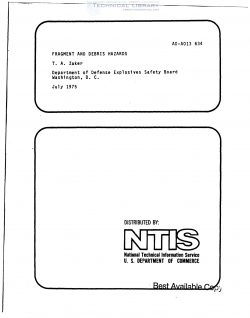DOD-TP-12
- Version
- 143 Downloads
- 1.21 MB File Size
- 1 File Count
- March 5, 2017 Create Date
- March 5, 2017 Last Updated
Fragment and Debris Hazards

FIT analysis of fragment and debris hazards is considerably less
developed a-Ian techniques for predicting blast damage from detonation
a quant i of explosivc material. Generally, whi L he effects of
t ceatcd deterministically, the investigation of fragment
nay b..
requi tes a probabi list ic approach. • The reason Cor this is L hat
f cagntc•. process involves a degree OL randomness in the phe-
of {raccure of metal casc material surrounding L he bursting
charge .
ffcnce the resul ting fragment mass distributions cannot be
predicted L com an underlying elementary theory, and variations are to
be cxpectcd in successive firings under ostensibly identical conditions.
Moreover, v. i ven the random nature of the breakup of case material, and
hence or the ballistic properties of fragments, tcminal ballistic
such as the impact distance and velocity will also exhibit
'A tat istical variations. The L erminal bal properties in turn
z:eterrninc.• hazard levels.
The distribution Of number mass, and their velocities, are detonation of single weapons in of fragments with respect to f ragment determined experimentally by static an arena of witness panels and recovery boxes containing material in which fragments are trapped, and from which they can be separated. Screening or magnetic separation techniques are used if the recovery medium consists of loose material such as sawdust . F i bcrboard bundies or card packs, if used as fragment traps, are about a meter thi Ck. They require disassembly and a tedious process of fragment extraction.
| File | Action |
|---|---|
| DOD-TP-12 Fragment and Debris Hazards.pdf | Download |

Comment On This Post